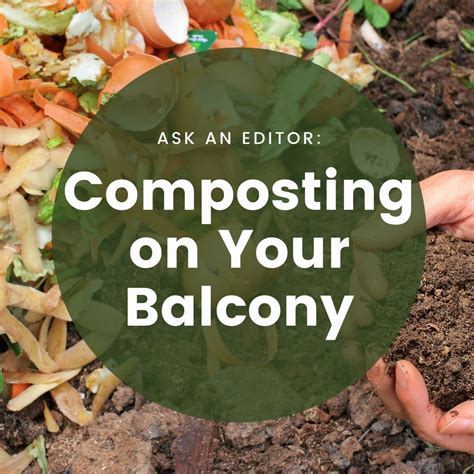Effective Balcony Composting: Essential Tips for Urban Gardeners
Composting on your balcony is a sustainable, eco-friendly way to recycle organic waste and enrich your gardening soil. Whether you’re new to composting or an experienced gardener, this guide offers practical tips for composting in small urban spaces. With a few containers, care, and the right design, you can successfully turn food scraps into nutrient-rich soil for your plants.
Introduction
Composting doesn’t require large yards or fancy setups. Urban dwellers with limited space can compost on a balcony, contributing to sustainability and reducing household waste. This guide covers tips for balcony composting, selecting containers, ensuring proper care, and helping your plants grow in nutrient-rich soil.
Key Concepts
- Aeration: Oxygen is essential for effective composting. Ensure your compost is well-ventilated.
- Moisture Control: Keep the compost moist, but not wet. Balance green (wet) and brown (dry) materials.
- Heat Generation: Proper composting generates heat, speeding up decomposition.
- Container Selection: Choose a container that allows for proper airflow and drainage.
Historical Context
Composting has been practiced for centuries. In urban environments, however, limited space has posed challenges. Balcony composting is a modern adaptation that helps city dwellers engage in sustainable practices while reducing organic waste and promoting plant growth. The rise of small-scale gardening during the pandemic has also fueled the demand for creative solutions like balcony composting.
Current State Analysis
Composting is becoming increasingly popular in urban areas. With more people living in apartments and smaller spaces, there’s a growing need for innovative composting methods. Balcony composting provides a compact and efficient way to manage organic waste. However, misconceptions about odor, pests, and maintenance often deter people from starting. Proper care and design are key to overcoming these challenges.
Practical Applications
- Container Selection: Use a compost bin that fits the size of your balcony. Choose one with good airflow and drainage.
- Layering: Start with a layer of dry materials (brown) like leaves or cardboard, followed by wet materials (green) such as vegetable scraps.
- Avoiding Pests: Cover food scraps with a layer of brown material to prevent pests and control odor.
- Moisture Management: If the compost is too wet, add more dry material. If too dry, lightly water it.
Case Studies
| Location | Setup | Successes | Challenges |
|---|---|---|---|
| New York City | Plastic bin with air holes | Rich compost in 6 months | Managing moisture during winter |
| Tokyo | Ceramic composting pot | Minimal smell and pest issues | Finding the right balance of green/brown materials |
| London | DIY wooden box | Increased plant growth | Attracting flies in the summer |
Stakeholder Analysis
- Apartment Dwellers: Can reduce waste and grow plants.
- Local Communities: Decreases landfill waste and promotes sustainability.
- Government Agencies: Encouraging balcony composting can reduce municipal waste costs.
Implementation Guidelines
- Step 1: Choose a suitable compost bin with adequate ventilation and drainage.
- Step 2: Place your bin in a shaded spot on the balcony to prevent it from overheating in direct sunlight.
- Step 3: Start layering green and brown materials. Green materials include food scraps and grass clippings, while brown materials are cardboard, leaves, and straw.
- Step 4: Turn the compost regularly to promote aeration and speed up decomposition.
- Step 5: Monitor moisture levels. If it feels dry, add water; if it’s too wet, add more brown materials.
Ethical Considerations
Composting on your balcony is generally eco-friendly, but it’s important to consider your neighbors and potential environmental impacts. Smells, pests, and runoff could become problematic if compost is improperly managed. Consider using odor-neutralizing techniques, like adding carbon-rich materials and keeping your bin covered. Additionally, ethical disposal of non-compostable waste must be practiced.
Limitations and Future Research
- Space Constraints: Balconies have limited space, making it difficult for large-scale composting.
- Environmental Conditions: Weather can affect the composting process, particularly in extreme heat or cold.
- Composting Speed: Balcony composting may take longer due to smaller compost bins and less heat generation compared to larger setups.
- Future Research: Exploring new materials for balcony compost bins that can improve efficiency, such as insulated containers for cold climates.
Expert Commentary
Experts in urban gardening agree that composting on a balcony is a simple yet effective way to reduce waste and grow healthier plants. The main challenges, such as maintaining the right balance of moisture and airflow, can be easily managed with a well-ventilated bin and regular turning of the compost. For apartment dwellers looking to live more sustainably, balcony composting offers a practical solution without requiring extensive space or equipment. Future innovations in compost bin design, especially for urban settings, could further improve the efficiency and accessibility of this eco-friendly practice.


